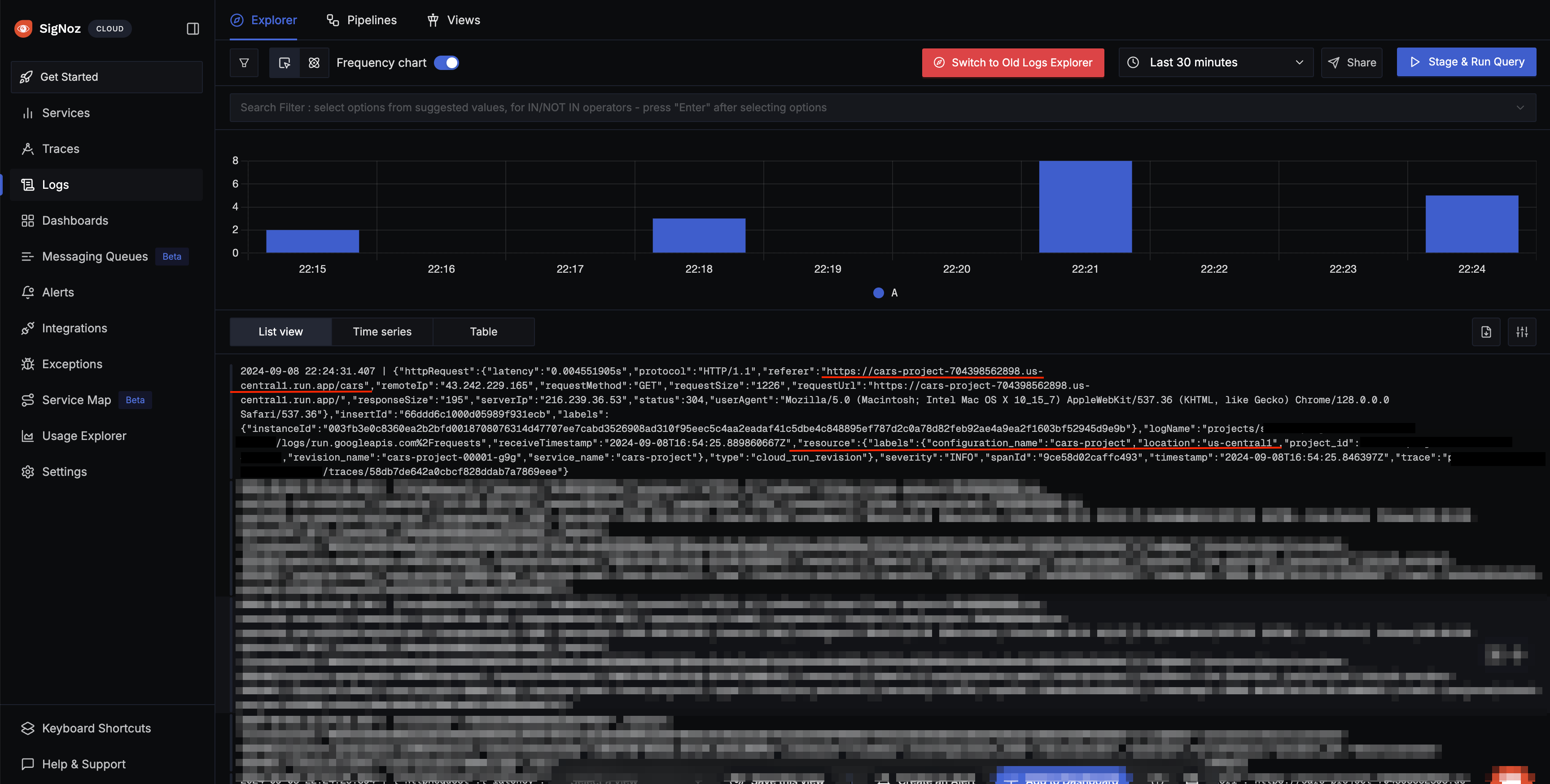Cloud Run Logging
Overview
This documentation provides a detailed walkthrough on how to set up Cloud Run to send the logs directly to SigNoz. By the end of this guide, you will have a setup that automatically sends your Cloud Run logs to SigNoz.
Here's a quick summary of what we will be doing in this guide
- Create and configure Cloud Run
- Create Pub/Sub topic
- Create Log Router to route the Cloud Run service logs to SigNoz
- Create Compute Engine instance
- Create OTel Collector to route logs from Pub/Sub topic to SigNoz Cloud
- Send and Visualize the logs in SigNoz Cloud
Prerequisites
- Google Cloud account with administrative privilege or Cloud Run Admin, Artifact Registry Admin, Compute Engine Admin, Pub/Sub Admin and Logging Admin privileges.
- SigNoz Cloud Account (we are using SigNoz Cloud for this demonstration, we will also need ingestion details. To get your Ingestion Key and Ingestion URL, sign-in to your SigNoz Cloud Account and go to Settings >> Ingestion Settings)
- Access to a project in GCP
Setup
Get started with Cloud Run service setup
Follow the steps mentioned in the Cloud Run Service Setup page to create Cloud Run Service.
Create Pub/Sub Topic
Follow the steps mentioned in the Creating Pub/Sub Topic document to create the Pub/Sub topic.
Create Log Router to Pub/Sub Topic
Follow the steps mentioned in the Log Router Setup document to create the Log Router.
To ensure you filter out only the Cloud Run logs, use the following filter conditions:
resource.type="cloud_run_revision"
resource.labels.service_name="<cloud-run-service-name>"
Setup OTel Collector
Follow the steps mentioned in the Creating Compute Engine document to create the Compute Engine instance.
Install OTel Collector as agent
Firstly, we will establish the authentication using the following commands:
- Initialize
gcloud:
gcloud init
- Authenticate into GCP:
gcloud auth application-default login
Let us now proceed to the OTel Collector installation:
Step 1: Download otel-collector tar.gz for your architecture
wget https://github.com/open-telemetry/opentelemetry-collector-releases/releases/download/v0.116.0/otelcol-contrib_0.116.0_linux_amd64.tar.gz
Step 2: Extract otel-collector tar.gz to the otelcol-contrib folder
mkdir otelcol-contrib && tar xvzf otelcol-contrib_0.116.0_linux_amd64.tar.gz -C otelcol-contrib
Step 3: Create config.yaml in the folder otelcol-contrib with the below content in it. Replace <region> with the appropriate SigNoz Cloud region. Replace SIGNOZ_INGESTION_KEY with what is provided by SigNoz:
receivers:
otlp:
protocols:
grpc:
endpoint: 0.0.0.0:4317
http:
endpoint: 0.0.0.0:4318
googlecloudpubsub:
project: <gcp-project-id>
subscription: projects/<gcp-project-id>/subscriptions/<pubsub-topic's-subscription>
encoding: raw_text
processors:
batch: {}
resource/env:
attributes:
- key: deployment.environment
value: prod # can be dev, prod, staging etc. based on your environment
action: upsert
exporters:
otlp:
endpoint: "ingest.<region>.signoz.cloud:443"
tls:
insecure: false
headers:
"signoz-ingestion-key": "<SigNoz-Key>"
service:
pipelines:
traces:
receivers: [otlp]
processors: [batch]
exporters: [otlp]
metrics:
receivers: [otlp]
processors: [batch]
exporters: [otlp]
logs:
receivers: [otlp, googlecloudpubsub]
processors: [batch, resource/env]
exporters: [otlp]
Step 4: Once we are done with the above configurations, we can now run the collector service with the following command:
From the otelcol-contrib, run the following command:
./otelcol-contrib --config ./config.yaml
Run in background
If you want to run OTel Collector process in the background:
./otelcol-contrib --config ./config.yaml &> otelcol-output.log & echo "$!" > otel-pid
The above command sends the output of the otel-collector to otelcol-output.log file and prints the process id of the background running OTel Collector process to the otel-pid file.
If you want to see the output of the logs you’ve just set up for the background process, you may look it up with:
tail -f -n 50 otelcol-output.log
You can now trigger the Cloud Run service URL a few times, and see the logs from the Cloud Run service on SigNoz Cloud.

Cloud Run Logs in SigNoz Cloud
Last updated: September 8, 2024
